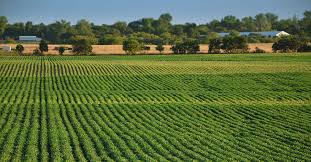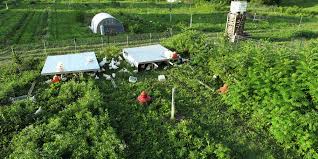The World Economic Forum describes regenerative agriculture as the way forward to decarbonize the food system and make farming resilient to climate shocks. This unconventional farming practice is based on five fundamental principles.
i. Promote biodiversity through the integration of animals and plants
ii. Improve soil health by adopting all options that will reduce soil disturbance
iii. Practice soil conservation by keeping the soil surface covered as much as possible
iv. Practice crop diversity by growing varieties of crops on the same field
v. Maintain living roots by planting perennial crops or cover crops
Principles of Regenerative Agriculture

1. Enhancing Soil Health: Regenerative agriculture aims to improve soil health by increasing organic matter, which enhances nutrient availability, soil structure, and water retention. Healthy soils promote plant growth and yield.
2. Increasing Biodiversity: Promoting a diverse ecosystem both above and below ground is essential. This includes crop rotation, integrating livestock, and planting cover crops to encourage diverse soil microbiomes, which support healthier plants and natural pest control.
3. Minimizing Soil Disturbance: Reduced tillage or no-till practices help preserve soil structure and reduce erosion. Minimizing soil disturbance maintains beneficial microorganisms and reduces carbon loss from the soil, preserving its fertility.
4. Integrating Animals: Livestock integration in regenerative systems adds organic matter to the soil through manure and enhances nutrient cycling. Managed grazing also improves grasslands and provides natural weed control.
5. Prioritizing Renewable Resources: Regenerative agriculture uses renewable inputs and reduces reliance on synthetic fertilizers and pesticides, focusing on sustainable, low-input systems. This approach minimizes environmental impact and enhances ecological balance.
Benefits of Regenerative Agriculture
1. Improved Soil Fertility: Regenerative practices increase soil organic matter, enhancing nutrient availability and soil structure. This leads to healthier crops and reduces the need for chemical fertilizers over time.
2. Increased Biodiversity: By encouraging plant and animal diversity, regenerative agriculture creates balanced ecosystems that are more resilient to pests and diseases. Biodiversity also attracts pollinators, essential for crop productivity.
3. Enhanced Water Retention: Practices like cover cropping and no-till increase the soil’s water-holding capacity, helping crops withstand drought conditions. Improved water retention also reduces runoff, preventing soil erosion and waterway pollution.
4. Carbon Sequestration: Regenerative practices, especially no-till and cover cropping, help sequester carbon in the soil, reducing greenhouse gases in the atmosphere. This contributes to climate change mitigation.
5. Reduced Input Costs: By using natural methods of fertility and pest control, farmers can reduce their dependence on costly synthetic inputs. Lower input costs, combined with healthier soils, result in more profitable farming over time.
Key Practices in Regenerative Agricultural
1. Cover Cropping: Planting cover crops between main crops helps protect soil from erosion, suppresses weeds, and adds organic matter. Cover crops also enhance soil biodiversity and improve nutrient cycling.
2. Crop Rotation: Growing different crops in sequence reduces soil nutrient depletion and breaks pest and disease cycles. Diverse crop rotations promote soil health and reduce the need for synthetic inputs.
3. Reduced Tillage: Limiting tillage maintains soil structure, retains moisture, and minimizes carbon release. Reduced tillage encourages soil microbiome diversity, which enhances plant nutrient availability.
4. Composting and Manure Application: Adding compost and manure enriches the soil with organic matter and nutrients. This practice supports soil organisms and improves soil structure, making it more resilient and productive.
5. Managed Grazing: Rotational grazing involves moving livestock through different paddocks, allowing grasses time to recover. This practice improves soil structure, adds organic matter, and promotes pasture health.
Read Also: 14 Medicinal Health Benefits of Caltha palustris ( Marsh Marigold)
Soil Health and Regenerative Agriculture

1. Organic Matter Enrichment: Regenerative practices increase soil organic matter, which is critical for retaining nutrients and water. Higher organic matter improves soil structure, making it less susceptible to erosion and compaction.
2. Microbial Activity: Soil health is closely tied to microbial diversity and activity. Practices like cover cropping and reduced tillage enhance soil microorganisms, which aid in nutrient cycling and plant growth.
3. Erosion Prevention: Regenerative agriculture reduces soil erosion through cover crops, ground cover maintenance, and no-till methods. These practices keep soil in place, preventing nutrient loss and protecting water quality.
4. Enhanced Water Infiltration: Healthy soils have improved structure, which promotes water infiltration. Increased infiltration allows for better root growth and reduces water runoff, helping prevent floods and drought stress.
5. Resilience to Climate Change: Healthier soils with more organic matter and microbial life can better withstand climate extremes. This resilience helps farmers maintain productivity in the face of variable weather conditions.
Role of Biodiversity in Regenerative Agriculture
1. Ecosystem Resilience: Biodiversity strengthens ecosystems, making them more resilient to environmental stressors like pests, diseases, and extreme weather. Diverse plant and animal species interact to support a balanced and self-sustaining environment, reducing the need for chemical inputs.
2. Soil Health and Microbial Diversity: Biodiversity enhances soil health by supporting a wide range of soil organisms, such as bacteria, fungi, and insects. These organisms help decompose organic matter, fix nitrogen, and break down minerals, all of which make nutrients available to plants. A more diverse soil microbiome also improves plant immunity and growth.
3. Pest and Disease Control: A diverse ecosystem naturally controls pest populations, as predator insects and beneficial organisms keep pest numbers in check. Crop diversity and companion planting also discourage pest infestations by creating an environment that disrupts pest life cycles.
4. Pollination and Crop Productivity: Biodiversity attracts pollinators, such as bees, butterflies, and birds, which are essential for many crops. By encouraging pollinator habitats, regenerative agriculture increases crop yields and quality, enhancing the overall productivity of the farming system.
Carbon Sequestration and Climate Impact
1. Soil Carbon Storage: Regenerative agriculture practices, such as cover cropping, no-till, and agroforestry, enhance the soil’s ability to capture and store carbon. As plants grow, they absorb CO₂ from the atmosphere through photosynthesis. When plants die, the carbon they stored is incorporated into the soil as organic matter, where it remains sequestered, reducing atmospheric CO₂.
2. Climate Change Mitigation: Carbon sequestration directly impacts climate change by reducing the amount of CO₂ in the atmosphere. As regenerative practices spread, the cumulative effect of soil carbon storage could significantly lower greenhouse gas emissions, helping slow the rate of global warming.
3. Perennial and Deep-Rooted Plants: Planting perennials and deep-rooted plants improves soil structure and increases carbon sequestration. Deep-rooted plants pull carbon deeper into the soil, where it is stored for longer periods and is less likely to be released back into the atmosphere.
4. Reduction of Greenhouse Gases: Regenerative agriculture also helps lower greenhouse gas emissions by reducing the need for synthetic fertilizers, which are energy-intensive to produce and emit nitrous oxide (a potent greenhouse gas) when applied to fields. By emphasizing compost and other organic inputs, regenerative systems reduce these emissions.
Water Management Techniques
1. Improved Water Retention: Regenerative practices increase soil organic matter, which enhances the soil’s water-holding capacity. This helps crops survive droughts and reduces the need for irrigation, making water management more sustainable and less resource-intensive.
2. Cover Cropping: Cover crops protect soil from erosion and improve water infiltration by breaking up compacted soil layers. These crops also act as a mulch, reducing evaporation and helping the soil retain moisture, which is essential for water conservation.
3. Agroforestry and Windbreaks: Planting trees and shrubs alongside crops provides shade, reduces wind erosion, and helps retain soil moisture. The root systems of trees also stabilize the soil, prevent runoff, and support water infiltration, contributing to sustainable water use.
4. Reduced Irrigation Needs: Healthy soils with high organic content retain water more effectively, meaning less irrigation is required. Practices like drip irrigation and mulching further minimize water use by delivering water directly to the plant roots and reducing surface evaporation.
Regenerative Agriculture vs. Conventional Farming
1. Soil Health: While conventional farming often relies on synthetic inputs that degrade soil health over time, regenerative agriculture emphasizes soil-building practices. Regenerative techniques enhance soil fertility naturally through composting, cover cropping, and minimal tillage, resulting in long-term soil health and productivity.
2. Chemical Inputs: Conventional farming tends to rely heavily on synthetic fertilizers, pesticides, and herbicides to boost crop yield. Regenerative agriculture, on the other hand, seeks to eliminate or significantly reduce these inputs by using organic fertilizers and promoting natural pest control, which reduces environmental pollution and improves ecosystem health.
3. Carbon Footprint: Conventional farming practices often have a high carbon footprint due to heavy machinery use, tillage, and chemical inputs. Regenerative agriculture’s focus on carbon sequestration, reduced tillage, and local inputs minimizes its carbon footprint and contributes to climate change mitigation.
4. Biodiversity Impact: Conventional farming is usually based on monoculture, which limits biodiversity and makes crops more susceptible to pests and diseases. In contrast, regenerative agriculture embraces crop diversity, companion planting, and the integration of livestock to create a balanced, biodiverse ecosystem that promotes resilience and sustainability.
5. Long-Term Sustainability: Conventional farming can lead to soil degradation, water depletion, and ecosystem damage over time. Regenerative agriculture, with its focus on sustainability and resource conservation, aims to restore ecosystems, enhance soil health, and make farming practices resilient to environmental challenges in the long term.
Read Also: 11 Medicinal Health Benefits of Albizia julibrissin (The Persian Silk Tree)
Challenges in Adopting Regenerative Practices

1. Initial Costs and Investment: Transitioning to regenerative agriculture can require significant upfront investments in new equipment, soil amendments, and seeds for cover crops. Additionally, some regenerative practices, like planting trees for agroforestry or setting up rotational grazing systems, may require a substantial initial financial commitment. For small-scale farmers or those with limited resources, these costs can be a barrier.
2. Knowledge and Training Gaps: Many farmers are unfamiliar with regenerative practices, particularly if they have been using conventional methods for a long time. Learning new techniques—such as no-till farming, cover cropping, or composting—requires time and training. Access to educational resources and mentorship is essential for a successful transition, yet these resources are not always available in every region.
3. Transition Period and Yield Fluctuations: It can take several years for soil health and productivity to improve after switching to regenerative practices. During this transition period, farmers may experience lower yields, which can impact their income and food security. The uncertainty surrounding yield during the transition phase can deter farmers from adopting regenerative methods, especially if they rely on their crops for livelihood.
4. Access to Markets and Financial Incentives: Regenerative products often lack certification or recognition in conventional markets. Without clear labeling and financial incentives for regenerative products, it can be challenging for farmers to find a premium market that rewards sustainable practices. Additionally, government subsidies and support often favor conventional farming, leaving regenerative farmers with fewer financial incentives.
5. Cultural and Social Resistance: Farming practices are often deeply rooted in cultural and regional traditions. Introducing regenerative methods may face resistance due to longstanding farming practices that prioritize short-term yield. Farmers may be reluctant to change if they perceive regenerative agriculture as too experimental or risky compared to conventional approaches.
6. Climate and Environmental Factors: Regenerative practices are not a one-size-fits-all solution; they need to be adapted to local climate conditions and soil types. Farmers in arid regions, for example, may find cover cropping challenging due to limited water availability. Tailoring regenerative practices to suit specific environmental conditions is necessary but can be difficult without proper guidance.
Do you have any questions, suggestions, or contributions? If so, please feel free to use the comment box below to share your thoughts. We also encourage you to kindly share this information with others who might benefit from it. Since we can’t reach everyone at once, we truly appreciate your help in spreading the word. Thank you so much for your support and for sharing!
Read Also: Product Concept Development and Evaluation

